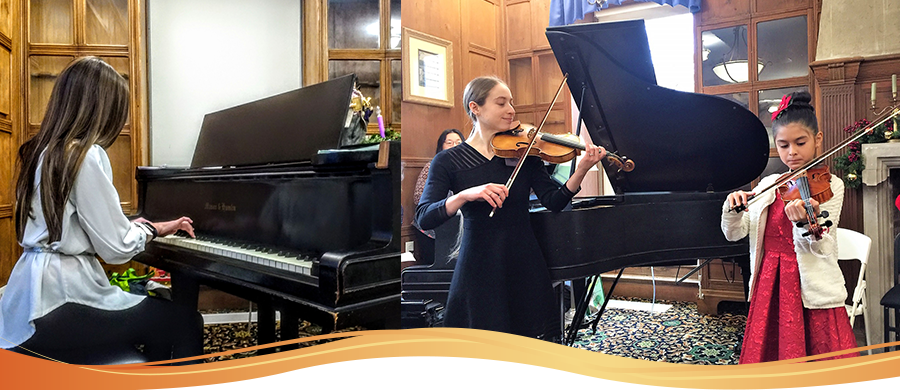
Online
Music for the Community
If you're interested in a particular category, you can sort performances by student age, instrument, singalong music, composer and so on - click on the orange tags under the text. We hope you and your family will enjoy watching our students share their music!
To have each week's videos and accompanying info sent to your inbox*, please subscribe via the orange button.
*Videos are delivered twice weekly; you can unsubscribe at any time, and we will never share or sell your info.
Subscribe to this Page
Displaying items by tag: Students age 3 to 5
Day 53 - Mary Had a Little Lamb (piano)
Pianist age 4 plays "Mary had a Little Lamb"
We've shown Mary had a Little Lamb before, on flute, but of course it sounds very different on piano. People are often surprised to learn that although the piano has strings, it's actually classifed as a percussion instrument. But percussion basically means "instruments that make their sound when you hit them," and that's what's happening here: when you press the piano keys, they operate hammers inside the piano, which hit the strings and bounce off again.
So an important skill for pianists is learning to touch the keys with enough strength for those hammers to produce a sound - but not so much that the sound is harsh. Although he's so young, you can see (and hear) that this young man is already doing an excellent job using the weight of his arm to drop his fingers into the keys, producing a round, ringing sound.
You probably already know that words to this song! But just in case:
Day 33: I Want a Popsicle
Day 33: Violinist age 5 plays Twinkle Variation D, “I Want a Popsicle”
Day 26 - Early Beginners play Twinkle (Skills, part 1)
We're doing something a little different this week - taking you on a journey from the earliest stages of learning an instrument through to musical mastery. First, our beginners who are just learning to pick out a simple tune...
Pianists age 4 play Twinkle, right hand and left hand
Day 24: Down Pony, Up Pony
Violinist age 5 plays Twinkle Variation C, "Down Pony, Up Pony"
Here is another variation on Twinkle, from one of our young Wayland Rec beginners. Again, this bowing pattern will show up later in much more advanced repertoire.
For violin, viola and cello, we call this variation “DOWN pony, UP pony” to emphasize the alternating direction of the strong bow strokes. Others like to call it “Long, short-short, Long, short-short”, while our Suzuki piano teachers often use “Run Mommy, Run Daddy”. Pick one of these, and see if you can keep up singing it all the way through - or maybe chase Mom and Dad around the house!
Day 11: Massachusetts Music (Twinkle Variation A)
Violinist age 4 plays Twinkle Variation A, Massachusetts Music
This is the first piece that the young musicians in our Suzuki Program learn. The rhythm “Massachusetts Music” is an easy one for beginners, as it uses very short bow strokes – but it’s also something that will reappear many times in much bigger pieces, including professional ones.
This little student started in our Wayland Recreation “Small Group Intro to Violin” class over the summer. Five months later, and she was ready to share her music with an audience. She gets extra brownie points for stopping to “build fingers” carefully when she moves to a new string. Skills built solidly in small steps like this will lead to ease and confidence at all levels of playing.


